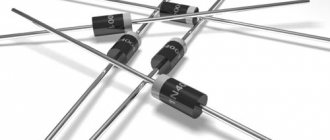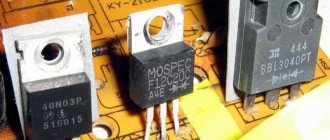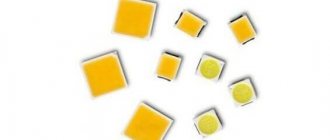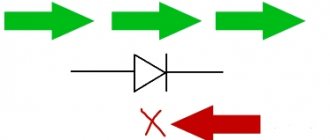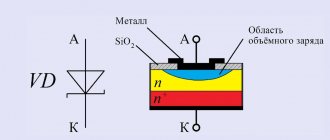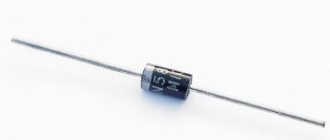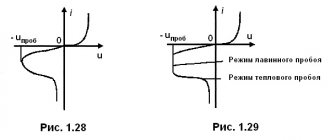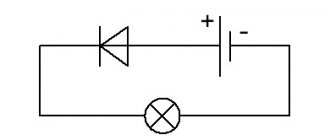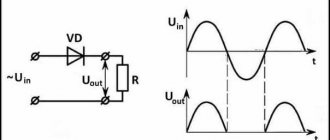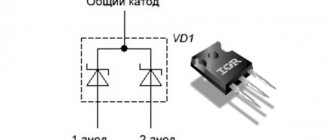- Plastic case.
- Fire resistance level 94V-0 according to Underwriters Laboratory Flammability classification.
- For surface mounting.
- The element has a small height.
- The housing design provides protection against excess tension on the leads.
- Metal-silicon transition, basic carriers are used.
- Low loss, high efficiency.
- High overload capacity.
- Low voltage drop of an open diode.
- High current resistance.
- Guardring protection (protective ring) from overvoltage.
Application area
The low recovery speed of SS14 opens up the possibility of using the element in pulsed devices for various purposes, as well as power supplies - high-frequency inverters that convert alternating voltage to direct voltage.
Due to their miniature size and housing features, diodes are widely used in various compact electronic devices with high packing density. In circuits, they protect active components from possible operating conditions such as overvoltage.
Another component of electronic gadgets where SS14 is widely used is circuits for replenishing electrical energy in smartphones, tablets, laptops and other mobile devices. Due to the low voltage drop across the open diode, their charging efficiency increases.
Functionality check
Sometimes the question arises about how to test an SS14 diode in an SMD package. As with most similar devices, this can be done with a regular multimeter, setting the dialing function on the latter. By applying a negative probe to the cathode (K) and a positive probe to the anode (A), you can observe the threshold voltage of the diode on the tester display when connected directly. The diode is considered to be in good condition if, after changing the location of the probes on the contacts, nothing is displayed on the tester display. That is, current does not flow in the opposite direction.
Limit values and electrical characteristics
The data in the table is valid at air temperatures up to 25°C.
| Designation | Parameter | Max. | Unit change |
| VRRM | Maximum Peak Reverse Voltage | 40 | V |
| VRMS | Maximum rms voltage | 28 | V |
| VDC | Maximum blocking DC voltage | 40 | V |
| I(AV) | Maximum average rectified forward current at TA=55°C | 1 | A |
| IFSM | Peak forward pulse current | 40 | A |
| VF | Maximum instantaneous forward voltage at 1.0A current | 0,5 | V |
| IR | Maximum continuous reverse current at TA = 25°C | 0,2 | µA |
| at rated blocking DC voltage and TA = 100°C | 6 | ||
| RθJA | Typical Thermal Resistance | 88 | °C/W |
| T.J. | Operating temperature range | -65… +125 | °C |
| TSTG | Storage temperature | -65… +150 | °C |
Peculiarities
For the production of ss14 diodes, rectangular SMA class packages are used. The letters SS in the product name indicate the following: the first – surface mounting, the second – the presence of a Schottky barrier. The terminals are made of tinning-treated brass. The cathode side is marked on the body, and different manufacturers designate it differently (dot, strip of a certain color, notch). Also, some companies shorten the model designation on the case to two digits - S4. The components are very lightweight - each unit weighs no more than 0.064 grams. The miniature size and features of mounting on a board are advantageous from the point of view of production processes, but make testing difficult - for this purpose the multimeter must be equipped with a special design.
Dimensions of Schottky smd parts
Important! On graphical representations of electrical circuits, such an element may be designated as standard for diodes or have some additional symbols.
Accepted graphical representation of a surface mount Schottky diode in circuit diagrams
The name of the class of diodes is associated with the name of the German physicist Walter Hermann Schottky, who was the first to describe the transition between a metal surface and a semiconductor material. In the products under consideration, this transition is created through direct contact of these two materials. The typical P–N implementation involving the phenomenon of electron-hole conduction is not used in the SS14 model. Electric current is created by electrons themselves. In different models of Schottky products, silver, gold or platinum conductors can be used. The semiconductor component may be silicon or made of gallium arsenide.
The advantages of using such parts are significant performance and low resistance when installing the element directly, which minimizes the reduction in voltage on it. This makes it possible to mount these diodes in pulse-type devices. In addition, the working transition zone has a low electrical capacity, which allows the use of these elements in high-frequency installations. Diodes also have weaknesses: they have little resistance to situations where the maximum reverse voltage is exceeded; heating entails a sudden increase in the reverse current. These features are associated with the design of diode components.
Imported and domestic analogues
Schottky diodes are produced by several manufacturers under the same name. These include Taiwan Semiconductor, Multicomp, Vishay Semiconductor. Therefore, you can look for a replacement for your diode in the corresponding catalogs of radio components of different brands.
The table shows possible analogues from different manufacturers. They have the same housings as the original, but may differ slightly in technical characteristics. Therefore, to ensure that replacement is possible, you must carefully study the datasheet of the analogue before the operation.
| Analogue | Reverse voltage (V) | Forward current (A) | Forward voltage (mV) |
| SS14 | 40 | 1 | 500 |
| STPS1L40A (ST) | 40 | 1 | 500 |
| MBRA140T3G (ONS) | 40 | 1 | 550 |
| STPS140A (ST) | 40 | 1 | 550 |
| MBRA140T3 (ONS) | 40 | 1 | 550 |
| SS14E-TP (MCC) | 40 | 1 | 600 |
| 10MQ040NTRPBF (VISHAY) | 40 | 1 | 540 |
| BYS10-45-E3/TR (VISHAY) | 45 | 1,5 | 500 |
| SS14-E3/61T (VISHAY) | 40 | 1 | 500 |
| B240A-E3/61T (VISHAY) | 40 | 2 | 550 |
| VS-15MQ040NTRPBF (VISH/IR) | 40 | 1,5 | 420 |
Manufacturers
SS14 is quite common and popular; it is produced by many foreign companies. Let's list just a few of them, whose products are best known in domestic radio stores: ON Semiconductor, Dc Components, Taiwan Semiconductor Company, Fairchild Semiconductor, Vishay Siliconix, Galaxy Semi-Conductor Holdings Limited, Jinan Gude Electronic Device, Yangzhou yangjie electronic, Nanjing International Group , Suntan Capacitors. You can download the datasheet in pdf format using the link with the name of the manufacturer.
Typical performance characteristics
Rice. 1. Dependence of forward current on temperature.
Rice. 2. Dependence of forward current on forward voltage.
Rice. 3. Dependence of forward pulse current on the number of periods of frequency 60Hz.
Rice. 4. Dependence of capacitance on reverse voltage.
Diode analogues
Characteristics of in5822 Schottky diodes
Since similar Russian-made products have more affordable prices, consumers are often interested in the question of the existence of Russian diode models that can be used as a replacement for the original. The reality is that there are no complete or functional domestic analogues for this product. Some other foreign-made components are often noted as full-fledged replacements for the diode in question: MBRA140TR, STPS140A, B140. Products of the SMAB14 brand are also indicated as being as close as possible, but not absolute analogues.
Variations of SS14 produced by different companies differ slightly in their performance. When considering analogues, one should take into account the relationships of the substitute with different variations of the original. For example, the same model can be a complete analogue of the SS14 SMD diode from one company and the closest one for a sample from another manufacturer. You also need to look directly at the technical and operational characteristics of the replacement option itself.
The type of diode radio components under consideration has a very wide scope of application. Any city dweller uses chargers containing this component every day. It is also used in a number of other areas, for example, in power converters and in high-power transistors as a protective element.
Manifestation of faults in Schottky diodes
As already noted, the failure of Schottky diodes is one of the main problems of modern power supplies. So what preliminary signs can be used to presumably determine their malfunction? There are several such signs. Firstly, in the event of breakdowns and leaks of the secondary rectifier diodes, as a rule, the protection is triggered and the power supply does not start. This can manifest itself in different ways:
- When the power supply is turned on, the fan “twitches,” that is, it makes several revolutions and stops; After this, the output voltages are completely absent, i.e. the power supply is blocked.
- After turning on the power supply, the fan “twitches” constantly, voltage ripples can be observed at the outputs of the power supply, i.e. the protection is triggered periodically, but the power supply is not completely blocked.
- A sign of a malfunction of Schottky diodes is extremely strong heating of the secondary radiator on which they are installed.
- A sign of Schottky diode leakage may be spontaneous shutdown of the power supply, and therefore the computer, when the load increases (for example, when running programs that ensure 100% processor load), as well as the inability to start the computer after an “upgrade”, although the power supply is sufficient.
In addition, it is necessary to realize that in power supplies with poor and ill-conceived circuit design, leakage of rectifier diodes leads to overloads of the primary circuit and to current surges through the power transistors, which can cause their failure. Thus, a professional approach to repairing power supplies dictates a mandatory check of the secondary rectifier diodes each time the power transistors-switches of the primary part of the power supply are replaced.
Basic Schottky diodes found in power supplies
Schottky TO-220 SBL2040CT 10A x 2 =20A 40V Vf=0.6V at 10A Schottky TO-247 S30D40 15A x 2 =30A 40V Vf=0.55V at 15A Ultrafast TO-220 SF1004G 5A x 2 =10A 200V Vf=0.97V at 5A Ultrafast TO -220 F16C20C 8A x 2 =16A 200V Vf=1.3V at 8A Ultrafast SR504 5A 40V Vf=0.57 Schottky TO-247 40CPQ060 20A x 2 =40A 60V Vf=0.49V at 20A Schottky TO-247 STPS40L45C 20 A x 2 =40A 45V Vf= 0.49VUltrafast TO-247 SBL4040PT 20A x 2 =40A 45V Vf=0.58V at 20ASchottky TO-220 63CTQ100 30A x 2 =60A 100 Vf=0.69V at 30ASchottky TO-220 MBR2545CT 15A x 2 =30A 45 V Vf=0.65V at 15ASchottky TO-247 S60D40 30A x 2 =60A 40-60V Vf=0.65V at 30ASchottky TO-247 30CPQ150 15A x 2 =30A 150V Vf=1V at 15ASchottky TO-220 MBRP3045N 15A x 2 =30A 45V Vf=0.65V at 15ASchottky TO -220 S20C60 10A x 2 =20A 30-60V Vf=0.55V at 10ASchottky TO-247 SBL3040PT 15A x 2 =30A 30-40V Vf=0.55V at 15ASchottky TO-247 SBL4040PT 20A x 2 =40A 30-40V Vf=0 .58 V at 20A Ultrafast TO-220 U20C20C 10A x 2 =20A 50-200V Vf=0.97V at 10A
There are also modern domestic diode assemblies for high current. Here are their markings and internal diagram:
High-voltage Schottky power diodes with voltages up to 1200 V
Although it is more preferable to use Schottky diodes in low-voltage powerful rectifiers with output voltages of a couple of tens of volts at high switching frequencies.
The development of electronics requires increasingly higher standards from radio components. To operate at high frequencies, a Schottky diode is used, which is superior in its parameters to silicon analogues. Sometimes you can come across the name Schottky barrier diode, which basically means the same thing.
- Design
- Miniaturization
- Use in practice
Video
Coffee capsule Nescafe Dolce Gusto Cappuccino, 3 packs of 16 capsules
1305 ₽ More details
Coffee capsules Nescafe Dolce Gusto Cappuccino, 8 servings (16 capsules)
435 ₽ More details
Brother Laser MFPs
Schottky diodes from 1 Ampere
Buy
Package:
| SM5819 | 40V | 1A | 25A | 0.6V | 1.0mA at 25°C and 10mA at 100°C | MELF | SS14 | 40V | 1A | 30A | 0.5V | SMA | SS16 | 60V | 1A | 30A | 0.7V | 0.5mA at 25°C and 50mA at 100°C | SMA | S100 | 100V | 1A | 30A | 0.85V | 0.5mA at 25°C and 20mA at 100°C | SMA | MS120 | 200V | 1A | 30A | 0.9V | 0.002mA at 25°C and 20mA at 125°C | SMA | SR24 | 40V | 2A | 50A | 0.5V | SMA | SR26 | 60V | 2A | 50A | 0.7V | 0.5 mA at 25°C and 20 mA at 100°C | SMA | SX34 (SK34A) | 40V | 3A | 80A | 0.5V | 0.2mA at 25°C and 20mA at 100°C | SMA | SX36 | 60V | 3A | 80A | 0.75V | 0.1mA at 25°C and 20mA at 100°C | SMA | SK34 | 40V | 3A | 100A | 0.5V | 0.5 mA at 25°C and 20 mA at 100°C | SMC | MB310 (SK39 PanJit) | 100V | 3A | 100A | 0.8V | 0.05mA at 25°C and 20mA at 100°C | SMC | MB510 (SK59 PanJit) | 100V | 5A | 100A | 0.8V | 0.05mA at 25°C and 10mA at 100°C | SMC | SVC10120VB | 120V | 10A | 200A | 0.79V | 0.010mA | TO-277B |
Defining an Element Type
It’s good if the size of the case allows you to put at least somewhat understandable markings on it. But most often the diodes are so small that it is difficult to mark them even with color. In this case, it is not possible to distinguish a diode from a zener diode, for example, because they are like twin brothers.
In such situations, only a schematic diagram of the apparatus from which the element was extracted will help. In accordance with it, you can determine the type of component and its brand. If this information is missing, you can try to search for a schematic diagram of the device being repaired on the Internet or take a photograph of the element and also go to the Internet and search by image.
Testing diodes with a multimeter or other tester should only be done after determining their type and brand, because different types are tested differently.
Classification
Diodes are electrical converting and semiconductor devices that have one electrical junction and two p-n junction outputs.
- in accordance with their purpose, diodes are most often rectifier, high-frequency and ultra-high-frequency, pulse, tunnel, reverse, reference type devices, as well as varicaps;
- in accordance with the design and technological characteristics, diodes can be represented by planar and point elements;
- in accordance with the source material, diodes can be germanium, silicon, gallium arsenide and other types.
In accordance with the classification, the most important parameters and characteristics of diodes are presented:
- maximum permissible indicators of reverse DC voltage level;
- maximum permissible indicators of the reverse voltage level of the pulse type;
- maximum permissible indicators of direct current of direct type;
- maximum permissible indicators of direct current of pulse type;
- rated direct current direct current;
- direct current voltage of a direct type under rated conditions, or the so-called “voltage drop”;
- direct current of reverse type, indicated under the conditions of the maximum permissible reverse voltage;
- spread of operating frequencies and capacitance indicators;
- breakdown voltage level;
- level of thermal housing resistance, depending on the type of installation;
- the maximum possible indicators of dissipative power.
Depending on the power level, semiconductor elements can be low-power, high-power or medium-power.
Advantages and disadvantages
Despite its good parameters, 1n5819 is not capable of becoming a full-fledged replacement for conventional pn junction rectifier diodes. This is due to its design features and properties. It works well in high-frequency circuits and heats up less due to its low forward voltage drop. But there are also disadvantages that outweigh all these advantages.
Compared to conventional diodes, which are unable to operate in high-frequency modes, Schottky diodes have a much lower maximum permissible reverse voltage. They have much higher leakage current, which increases disproportionately quickly with increasing chip temperature. This can be clearly seen if you compare the parameters from the datasheets of these devices with each other.
